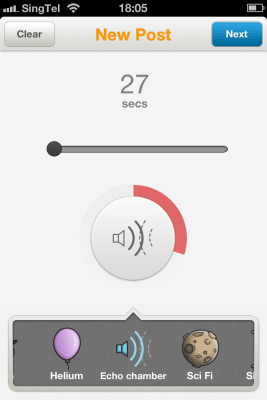Singapore-based Bubble Motion, the company behind sound-based social network Bubbly, unveiled a new version of its app today. The version 2.0 of Bubbly introduces filters users can apply to their voice, much like those Instagram offers for photos. Bubbly has a lot of traction already, including 19 million members mostly from Asian countries like Japan and India where it’s found favor with a lot of different celebrities (premium access to some of those celebs via a $2.99 in-app purchase is one of the startup’s revenue plays), and the new features seem designed to help the service keep its existing users engaged while it seeks out new audiences in other markets.
The new filters are tied to that expansion strategy, since they’re only available to iOS users, who represent a relatively new market for Bubble Motion. Bubbly managed to gain ground quickly by being not tied to any mobile smartphone platform, and instead existing as a voice service that could work with ordinary feature phones. The new app offers more flexibility, of course, and these voice filters are a good indication of where Bubbly can start to get creative and build on its earlier model, which most closely resembled a Twitter for voice complete with profiles and the ability to follow other users.
“As we put audio into your Twitter feed and your Facebook wall, we thought there needs to be some hooks that make you really want to keep coming back to Bubbly to record your audio,” Bubbly CEO Tom Clayton explained in an interview, describing how Bubbly took cues from Twitter and Instagram about what drove major growth around photo sharing on those services.” One of those [hooks], besides the user experience and the quality and everything else, is the filters.”
Bubbly 2.0 also brings Twitter or Facebook single-sign on to the app, which should lower the barrier for entry as well as speed up social sharing; introduces Facebook Timeline integration, which includes recording and liking in addition to listening; post deletion from within the app; and localization in Korean, Thai and Russian to help the smartphone app reach a wider audience in some of the markets closer to Bubbly’s original success. The company recently raised $5 million from Japan’s largest VC, in part to focus on U.S. growth, however, so it makes sense that in general the updates are ones that cater to popular social networks among that audience.
Still, Clayton says that the app’s biggest growth, both in terms of engagement and user base (both of which he says continue to trend upwards) comes from different Asian countries like the Philippines and Indonesia. The difference is that where before celebrities where driving a lot of new user sign-ups, now Bubbly is seeing much more peer-to-peer usage, with prominent bloggers especially driving use and new registration.
Other apps have found an audience with a voice changing gimmick, including Voices 2 by tap tap tap, the sequel to an app that had 600,000 users when the sequel hit the App Store. but Bubbly’s main play is still its social network elements which set it apart from those kinds of apps. We’ll see if users are encouraged to share more thanks to the addition of filters, or if this is a model that applies well to social photo sharing but falls flat with the spoken word.
